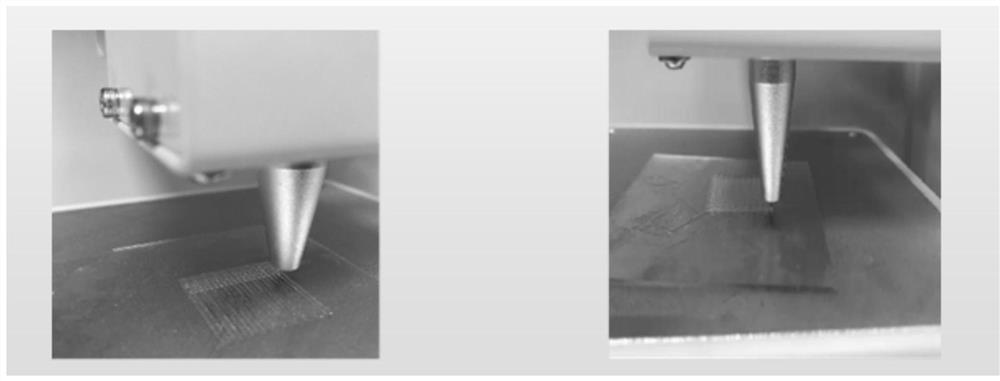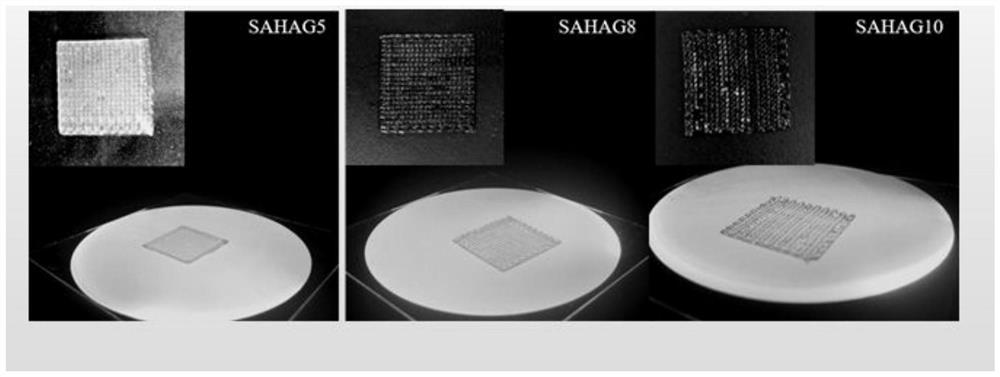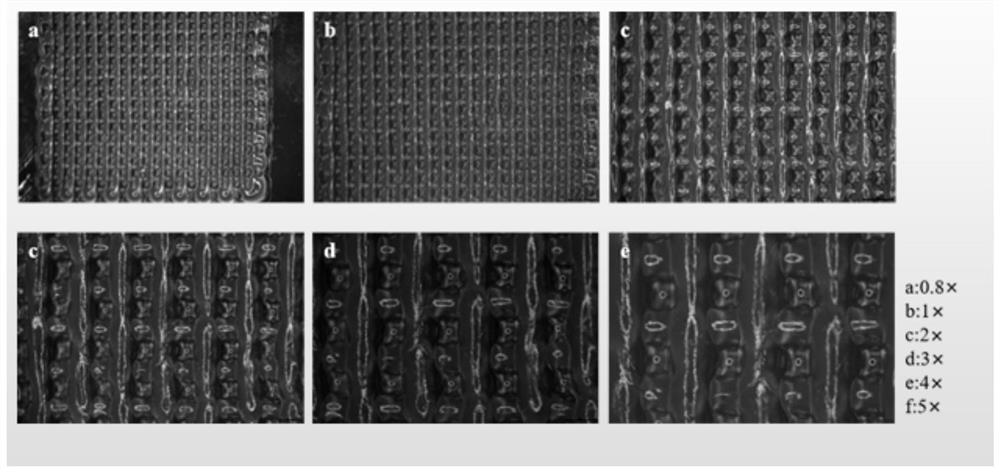3D bioprinted active biofilm for improved amic technology cartilage repair and its preparation method
An active biofilm, 3D printing technology, applied in tissue regeneration, prosthesis, additive processing, etc., can solve the problems of incompatibility of allogeneic bone reconstruction, different size and shape curvature, abnormal intra-articular stress, etc., to significantly promote cartilage. Ability, histocompatibility and biodegradability, and the effect of promoting cartilage regeneration
- Summary
- Abstract
- Description
- Claims
- Application Information
AI Technical Summary
Problems solved by technology
Method used
Image
Examples
Embodiment 1
[0060] 1) Premium printing materials
[0061] 1.1) Sterile treatment: gelatin, sodium alginate, hyaluronic acid, calcium chloride powder ultraviolet disinfection 24h, magnetic heating stirrer placed ultra-clean table to prepare hydrogel pre-gel prejugulation. All other operations are operating at ultra-clean table.
[0062] 1.2) Preparation of gelatin solution: 20 ml of deionized water was heated by 2.5 g gelatin 48 ° C water bath, and the constant temperature magnetic mixer was stirred, the rotational speed was adjusted to 300 r / min, allowing it to fully dissolve into a gelatin solution.
[0063] 1.3) Preparation of sodium alginate / gelatin solution: 20 mL of deionized water was added to the gelatin solution, 1.25 g of sodium alginate, 48 ° C water bath, and the rotational speed was 300 r / min, so that it was sufficiently dissolved into aza sodium alginate / gelatin solution.
[0064] 1.4) Preparation of sodium alginate / gelatin / hyaluronic acid mixed solution: 10 ml of sod...
Embodiment 2
[0073] 1) Premium printing materials
[0074] 1.1) Sterile treatment: gelatin, sodium alginate, hyaluronic acid, calcium chloride powder ultraviolet disinfection 24h, magnetic heating stirrer placed ultra-clean table to prepare hydrogel pre-gel prejugulation. All other operations are operating at ultra-clean table.
[0075] 1.2) Preparation of gelatin solution: 20 ml of deionized water was heated 48 ° C for 4G gelatin, stirring using a constant temperature magnetic mixer, and the rotational speed was adjusted to 300 r / min, allowing it to fully dissolve into a gelatin solution.
[0076] 1.3) Preparation of sodium alginate / gelatin solution: 20 mL of deionized water was added to the gelatin solution, 1.25 g of sodium alginate, 48 ° C water bath, and the rotational speed was 300 r / min, so that it was sufficiently dissolved into aza sodium alginate / gelatin solution.
[0077] 1.4) Preparation of sodium alginate / gelatin / hyaluronic acid mixed solution: 10 ml of sodium deionized...
Embodiment 3
[0086] 1) Premium printing materials
[0087] 1.1) Sterile treatment: gelatin, sodium alginate, hyaluronic acid, calcium chloride powder ultraviolet disinfection 24h, magnetic heating stirrer placed ultra-clean table to prepare hydrogel pre-gel prejugulation. All other operations are operating at ultra-clean table.
[0088] 1.2) Preparation of gelatin solution: 20 ml of deionized water was heated 48 ° C water bath, and the mixture was stirred using a constant temperature magnetic mixer, and the rotational speed was adjusted to 300 r / min, allowing it to fully dissolve into a gelatin solution.
[0089] 1.3) Preparation of sodium alginate / gelatin solution: 20 mL of deionized water was added to the gelatin solution, 1.25 g of sodium alginate, 48 ° C water bath, and the rotational speed was 300 r / min, so that it was sufficiently dissolved into aza sodium alginate / gelatin solution.
[0090] 1.4) Preparation of sodium alginate / gelatin / hyaluronic acid mixed solution: 10 ml of ...
PUM
| Property | Measurement | Unit |
|---|---|---|
| height | aaaaa | aaaaa |
Abstract
Description
Claims
Application Information
 Login to View More
Login to View More - R&D
- Intellectual Property
- Life Sciences
- Materials
- Tech Scout
- Unparalleled Data Quality
- Higher Quality Content
- 60% Fewer Hallucinations
Browse by: Latest US Patents, China's latest patents, Technical Efficacy Thesaurus, Application Domain, Technology Topic, Popular Technical Reports.
© 2025 PatSnap. All rights reserved.Legal|Privacy policy|Modern Slavery Act Transparency Statement|Sitemap|About US| Contact US: help@patsnap.com



